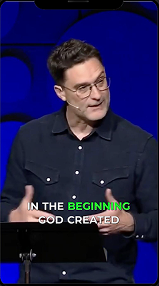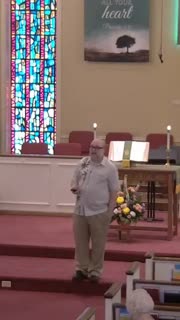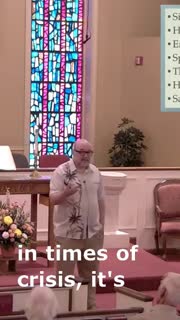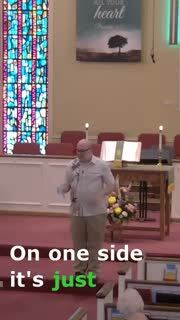Embracing the Power of Prayer and Gratitude
Summary
### Summary
Today, we gathered to celebrate Father's Day, and it was heartwarming to see everyone dressed in Hawaiian or print shirts. We began with some important announcements, including an upcoming presentation on the happenings in the UMC, a special Vacation Bible School for children with sensory issues, and a note of condolence for Jackie Purvis. After the announcements, we transitioned into worship with a prayer, asking for God's grace to move within us and empower us to share His love with others.
Our focus today was on the power of prayer, illustrated through the photograph "Grace" by Eric Enstrom. This image, taken during World War I, depicts a man praying over a simple meal, reminding us of the importance of gratitude even in times of hardship. The photograph's simplicity and depth resonate with many, making it one of the most reproduced images in the religious world. Enstrom's intention was to show that despite the sacrifices and chaos of war, there is always something to be thankful for.
We explored the teachings of Jesus on prayer, particularly from Matthew 6 and the Garden of Gethsemane. Jesus emphasized that prayer is a personal conversation with God, not a public display. He encouraged us to use our own words and to pray from the heart. In the Garden of Gethsemane, Jesus demonstrated the importance of praying with others and being honest with God about our fears and desires, while ultimately submitting to His will.
To foster a deeper prayer life within our community, we introduced a prayer calendar, encouraging everyone to pray for specific intentions each day of the week. This practice aims to unite us in prayer, support one another, and strengthen our connection with God.
### Key Takeaways
1. The Power of Simplicity in Prayer: The photograph "Grace" by Eric Enstrom captures the essence of prayer through its simplicity. It reminds us that even in times of great hardship, like during World War I, there is always something to be thankful for. This image teaches us that prayer doesn't need to be elaborate; it is the heartfelt connection with God that matters. [49:48]
2. Personal Connection with God: Jesus teaches us in Matthew 6 that prayer is a personal conversation between us and God. It is not meant for public display or to gain attention. True prayer comes from the heart, using our own words and expressing our genuine thoughts and feelings to God. This personal connection is what makes prayer powerful and meaningful. [55:01]
3. Praying with Others: In the Garden of Gethsemane, Jesus invited His disciples to pray with Him, showing the importance of communal prayer. Praying with others strengthens our faith and provides support during difficult times. Whether it's through small groups or community prayer boards, joining together in prayer fosters a sense of unity and shared purpose. [58:02]
4. Honesty in Prayer: Jesus' prayer in the Garden of Gethsemane teaches us to be honest with God about our fears and desires. He prayed for the cup of suffering to be taken away but ultimately submitted to God's will. This honesty in prayer allows us to express our true feelings while trusting in God's greater plan for our lives. [01:00:25]
5. Structured Prayer Practices: Introducing a prayer calendar helps us to develop a consistent and structured prayer life. By dedicating specific days to pray for different intentions, such as our community, church staff, and current events, we can unite as a church in prayer. This practice not only strengthens our individual prayer lives but also brings us together as a community of faith. [01:03:34]
### YouTube Chapters
[0:00] - Welcome
[08:17] - Announcements
[10:06] - Annual Conference Report
[29:29] - Children's Message
[40:17] - Offering Prayer
[43:43] - Art of Faith Series Introduction
[44:36] - World War I and Rationing
[45:38] - Eric Enstrom's "Grace"
[48:13] - Story Behind the Photograph
[49:48] - Meaning of "Grace"
[51:22] - Simplicity and Humility in Prayer
[53:01] - Sacrifice and Gratitude
[55:01] - Jesus' Teachings on Prayer
[58:02] - Praying with Others
[01:00:25] - Honesty in Prayer
[01:01:24] - Developing a Prayer Practice
[01:03:34] - Prayer Calendar Introduction
[01:11:33] - Final Blessing
Study Guide
### Bible Study Discussion Guide
#### Bible Reading
1. Matthew 6:5-8 (NIV)
> "And when you pray, do not be like the hypocrites, for they love to pray standing in the synagogues and on the street corners to be seen by others. Truly I tell you, they have received their reward in full. But when you pray, go into your room, close the door and pray to your Father, who is unseen. Then your Father, who sees what is done in secret, will reward you. And when you pray, do not keep on babbling like pagans, for they think they will be heard because of their many words. Do not be like them, for your Father knows what you need before you ask him."
2. Matthew 26:36-39 (NIV)
> "Then Jesus went with his disciples to a place called Gethsemane, and he said to them, 'Sit here while I go over there and pray.' He took Peter and the two sons of Zebedee along with him, and he began to be sorrowful and troubled. Then he said to them, 'My soul is overwhelmed with sorrow to the point of death. Stay here and keep watch with me.' Going a little farther, he fell with his face to the ground and prayed, 'My Father, if it is possible, may this cup be taken from me. Yet not as I will, but as you will.'"
#### Observation Questions
1. What does Jesus teach about the nature of prayer in Matthew 6:5-8? How does He contrast true prayer with the actions of the hypocrites?
2. In the Garden of Gethsemane, what emotions does Jesus express in His prayer, and how does He ultimately submit to God's will? ([01:00:25])
3. How does the photograph "Grace" by Eric Enstrom illustrate the simplicity and humility in prayer? ([49:48])
4. What are the key elements present on the table in the photograph "Grace," and what do they symbolize? ([51:22])
#### Interpretation Questions
1. Why does Jesus emphasize praying in private rather than in public? How does this teaching challenge our understanding of prayer? ([55:01])
2. How does Jesus' prayer in Gethsemane demonstrate the importance of honesty in our prayers? What can we learn from His willingness to express His fears and desires? ([01:00:25])
3. What role does communal prayer play in strengthening our faith, as seen in Jesus' invitation to His disciples to pray with Him in Gethsemane? ([58:02])
4. How can the practice of using a prayer calendar, as introduced in the sermon, help us develop a more structured and consistent prayer life? ([01:03:34])
#### Application Questions
1. Reflect on your own prayer life. Do you find yourself praying more in public or in private? How can you create a more intimate and personal prayer space in your daily routine? ([55:01])
2. Think about a time when you were honest with God in your prayers. How did it affect your relationship with Him? How can you incorporate more honesty in your prayers moving forward? ([01:00:25])
3. Have you ever participated in communal prayer? How did it impact your faith and sense of community? What steps can you take to engage more in communal prayer within your small group or church? ([58:02])
4. The photograph "Grace" emphasizes simplicity and gratitude in prayer. How can you simplify your prayer life to focus more on heartfelt connection with God? ([49:48])
5. Consider the idea of a prayer calendar. What specific intentions can you commit to praying for each day of the week? How might this practice enhance your spiritual growth and connection with your church community? ([01:03:34])
6. Jesus prayed for God's will to be done, even when it was difficult. Is there a situation in your life where you need to submit to God's will? How can you pray for strength and guidance in this area? ([01:00:25])
7. Identify one person in your life who might benefit from communal prayer. How can you invite them to join you in prayer or support them through your prayers this week? ([58:02])
Devotional
Day 1: The Power of Simplicity in Prayer
Prayer is a profound act that doesn't require elaborate words or grand gestures. The photograph "Grace" by Eric Enstrom, taken during World War I, captures a man praying over a simple meal. This image serves as a powerful reminder that even in times of great hardship, there is always something to be thankful for. The simplicity of the photograph resonates deeply, teaching us that the essence of prayer lies in a heartfelt connection with God, not in its complexity. This lesson encourages us to approach prayer with humility and gratitude, focusing on the sincerity of our hearts rather than the eloquence of our words. [49:48]
1 Thessalonians 5:16-18 (ESV): "Rejoice always, pray without ceasing, give thanks in all circumstances; for this is the will of God in Christ Jesus for you."
Reflection: Think of a simple moment in your day where you can pause and offer a prayer of gratitude. How can you make this a daily habit?
Day 2: Personal Connection with God
Jesus teaches us in Matthew 6 that prayer is a personal conversation between us and God. It is not meant for public display or to gain attention. True prayer comes from the heart, using our own words and expressing our genuine thoughts and feelings to God. This personal connection is what makes prayer powerful and meaningful. By focusing on our relationship with God rather than the opinions of others, we can cultivate a more authentic and intimate prayer life. [55:01]
Matthew 6:6 (ESV): "But when you pray, go into your room and shut the door and pray to your Father who is in secret. And your Father who sees in secret will reward you."
Reflection: Find a quiet place today where you can be alone with God. What personal thoughts and feelings do you need to share with Him?
Day 3: Praying with Others
In the Garden of Gethsemane, Jesus invited His disciples to pray with Him, showing the importance of communal prayer. Praying with others strengthens our faith and provides support during difficult times. Whether it's through small groups or community prayer boards, joining together in prayer fosters a sense of unity and shared purpose. This practice not only helps us to feel connected to one another but also amplifies the power of our prayers as we lift each other up. [58:02]
James 5:16 (ESV): "Therefore, confess your sins to one another and pray for one another, that you may be healed. The prayer of a righteous person has great power as it is working."
Reflection: Think of a friend or family member who might need prayer support. Can you reach out to them today and offer to pray together?
Day 4: Honesty in Prayer
Jesus' prayer in the Garden of Gethsemane teaches us to be honest with God about our fears and desires. He prayed for the cup of suffering to be taken away but ultimately submitted to God's will. This honesty in prayer allows us to express our true feelings while trusting in God's greater plan for our lives. Being transparent with God about our struggles and hopes can deepen our relationship with Him and help us to find peace in His sovereignty. [01:00:25]
Psalm 62:8 (ESV): "Trust in him at all times, O people; pour out your heart before him; God is a refuge for us."
Reflection: What is one fear or desire you have been hesitant to bring before God? Take a moment today to honestly share it with Him in prayer.
Day 5: Structured Prayer Practices
Introducing a prayer calendar helps us to develop a consistent and structured prayer life. By dedicating specific days to pray for different intentions, such as our community, church staff, and current events, we can unite as a church in prayer. This practice not only strengthens our individual prayer lives but also brings us together as a community of faith. A structured approach to prayer can help us to stay focused and intentional, ensuring that we cover a wide range of needs and concerns. [01:03:34]
Colossians 4:2 (ESV): "Continue steadfastly in prayer, being watchful in it with thanksgiving."
Reflection: Create a simple prayer calendar for the week. What specific intentions will you pray for each day? How can this practice help you stay committed to prayer?
Quotes
### Quotes for Outreach
1. "Prayer is a connection, discussion, a conversation between you and God. It's not for show. It's not and it's not beneficial. It's not for the benefit of those who have sinned. It's not for the benefit of anyone else but for you. He says don't be like those hypocrites who pray out on the street who are trying to bring use those prayers to bring attention to themselves. It's not what prayer is about. Prayer is about that connection between you and the God who created you and the God who loves you." (30 seconds)
2. "There's no right way or wrong way to pray. Pray with your eyes open. You can pray with your eyes open. You can pray with your eyes closed. You can pray with your hands out or up or by your side or in your pockets. It doesn't matter. You can speak the prayers verbally. You can say the prayers inwardly. You can use your own voice. You don't have to worry about anyone else judging you." (30 seconds)
3. "Prayer does a lot of different things for us. It brings us into the presence of God. It creates that relationship. It adds to our peace. That was Engstrom's, that was his goal, was to add to our peace. Find something to be thankful for in the midst of chaos. Build a connection to God." (30 seconds)
4. "In times of crisis, it's easy for us to make those sacrifices, to be called to sacrifice, to respond, to be called to sacrifice. Through sacrificial ways, but we as Christians are called to live lives of sacrifice, not just in times of great crisis or upheaval, but that's one of the founding principles that Christ calls us to, to sacrifice in the name of God, to give of ourselves, to give up comfort sometimes, so that others might come to know the grace of God." (41 seconds)
5. "It reminds them of something. Now, if we were to analyze, if we were to analyze this, you know, me looking at this, I would say, I would say, I would say, I would say, I would say, I would say, I'm kind of drawn to the simplicity of it. There's really not much to it. The background is, there's nothing in the background. You see some rays of light, maybe from a window. In the foreground, there's a few simple things on the table there. A Bible, eyeglasses, a bowl, which we can't tell what's in it, a loaf of bread and a knife to cut the bread with. Simplistic, simplicity." (35 seconds)
### Quotes for Members
1. "Jesus took his friends to the garden with him. said, y'all, come pray with me. Now, they fell asleep. Their bellies were full. They were half drunk. They wanted to, but they just couldn't stay awake. But Jesus took them nonetheless. Come pray with me. Praying with others is a part of our prayer life. I love that we have the prayer board out here and that we have neighbors who want to pray with us, who want us to pray with them. And so when we lift these up each Sunday, we are praying with others. And we are participating with others in their prayers." (38 seconds)
2. "Another way to pray with others is to pray within your small group. We have a number of small groups. They're printed here in the bulletin each week. If you're not part of a group that you can pray with, that you can interact with, that you can learn with, that can support you and you can support others, I encourage it. That's the way to faith. You know, Kathy talked about John Wesley. John Wesley earlier, the fact that we are called Methodists. You know what the method is in Methodists? to join small groups, to pray with others, to hold others up. It doesn't replace kind of a congregational support or participation, but it strengthens it." (48 seconds)
3. "Jesus knew what was happening. He was fully aware that he would be executed the next day. What was on his heart? He didn't want to go through it. He anticipated the pain, the agony that he would be facing, and he says, God, take this cup away from me. That was what was on his heart. He knew it wasn't what needed to be done, but he prayed it anyway. God, take this cup from me. And then followed up with, but not my will, but yours be done. He put himself in proper relationship with the creator who created him. He said, God, I want to be part of your world, of your kingdom. I've got this part to play, and I'm willing to play it. I don't want to, but I will." (55 seconds)
4. "Prayer does a lot of different things for us. It brings us into the presence of God. It creates that relationship. It adds to our peace. That was Engstrom's, that was his goal, was to add to our peace. Find something to be thankful for in the midst of chaos. Build a connection to God. There's no right way or wrong way to pray. Pray with your eyes open. You can pray with your eyes open. You can pray with your eyes closed. You can pray with your hands out or up or by your side or in your pockets. It doesn't matter. You can speak the prayers verbally. can say the prayers inwardly. You can use your own voice. You don't have to worry about anyone else judging you." (30 seconds)
5. "On one side it's just a lesson on how to pray. I don't want to assume that everybody, everybody has a vital prayer practice or that everyone is happy with the way that their prayer devotion time goes. So this is just help for anybody who needs other help with that, developing that time. But the prayer calendar that you see, I'd like for us as a church to join with others to pray for the bishop on Mondays. So whatever kind of prayer practice you have or are developing, pray on Mondays. Especially for our bishop and for the cabinet and for all of those who are working in the conference office. They're supervising clergy. They've got churches, over 200 churches that they're supervising as well. It's a difficult job." (49 seconds)













